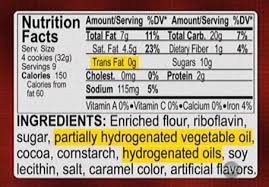
Don’t always believe nutrition labels that say “Zero Trans Fat,” but there is an easy way to tell if food contains this toxic substance.
Trans fats kill, but you already know that, but do you know how to tell if any particular food contains trans fats?
The food industry is guilty of a lot of deceptive labeling on bags, boxes and cans of food.
In fact, so pervasive is this deceptive labeling, that the result is a potentially harmful consumption of the synthetic, heart-harmful trans fats, says the Jan/Feb 2011 American Journal of Health Promotion.
This is scary because food labels are approved by the FDA! What is the daily allowed value for trans fats? 1.11 grams.
The American Heart Association warns that this dangerous substance should be limited for consumption.
But protocols set by the FDA impede the consumer’s ability to access the actual amount of trans fats in a food.
What is the current food label law regarding trans fats?
- A trans fat content of more than five grams can be listed in one-gram increments.
- Under five grams can be listed in one-half gram increments.
- Lower than one-half gram can be listed as zero grams of trans fats!
These allowances permit the food maker to list the trans fat content as “zero” if the food has a fraction less than one-half gram of this ingredient.
Since the daily recommendation limit set by the AHA is just 1.11 grams, you can see how such deceptive food labeling can lead to harmful consumption of this poison.
The food maker gets away with this scam by listing a “serving size” on the nutrition label as small enough to contain under one-half gram of trans fat.
Most consumers look at the words “serving size,” and then their eyes go over to the calories, and then maybe over to the sodium or sugar content.
Do you ever check out the quantity that constitutes the “serving size”? It’s often laughably small: maybe a few bites’ worth or a few pieces or half the cookie in that plastic wrap.
Come on, are you going to stop eating that cookie after just one-half is gone, and put the remaining half back in the torn wrapper?
If you think these sub-half-gram values are negligible, they’ll add up quickly to over 1.11 grams per day in just three food items eaten a day, in which the labeling is deceptive regarding trans fats.
If you increase everyday ingestion of this man-made substance from nine-tenths percent to 2.1 percent (two grams to 4.67 grams), your risk of cardiovascular disease jumps by 30 percent.
How to Tell if Food Contains Trans Fats Even if the Package or Box Says “Zero Trans Fats Per Serving.”
“One rule of thumb is that foods that contain vegetable shortening is typically made from partially hydrogenated vegetable oil,” says Shana Spence, MS, RDN, CDN, a registered dietitian nutritionist based in New York.
Spence explains, “These include many cakes, cookies and other pastries that are sometimes sold in bakeries and diners.
“Fried foods, especially those made in fast food restaurants, will often contain trans fats.
“And more often than not, these places reuse the oils which increases the amount of trans fats.”
Ignore the Front of the Package; Read the Ingredients List
Often, the ingredients are in super tiny print. Use a magnifying glass if you must. Often, the ingredients list is lengthy. Take the time to read every word!
If the ingredients list contains the following items, the food has trans fats:
- “Partially hydrogenated” or just “hydrogenated.” But if it says “fully” or “completely” hydrogenated, it doesn’t contain trans fat. If it only says “hydrogenated,” you don’t know if it’s fully or partially.
- Shortening
- Canola oil (the processing of this oil creates trans fats).

 Shana Spence
Shana Spence









